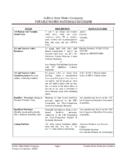Transcription of Pipeline coatings 24 - otkrit1.com
1 Pipeline coatings Todd Byrnes 24. Saudi Aramco, Dhahran, Saudi Arabia Introduction It is hoped by the end of this chapter that the reader will leave with some understanding of what coatings are available and the salient points about how they function. In addi- tion, current trends in coating research and the key factors driving these efforts will be illustrated. Practical implementation of new technologies is the key focus, rather than an in-depth analysis of the science. When people talk about Pipeline coatings , they think of them primarily as a barrier to aqueous corrosion.
2 While that is a major role, coatings do so much more than just block moisture. Some other functions include the following: Separating the Pipeline from corrosive chemicals, gases, and microbiologically in uenced corrosion (MIC). Reducing the amount of cathodic protection current required for corrosion mitigation. Protecting piping against Corrosion Under Insulation (CUI). Re ection of thermal radiation and insulation of the pipe contents from heat loss or heat gain. Reducing the friction between the liquid media and the pipe wall.
3 Resisting abrasion and impact during transportation and burial. Controlling pipe buoyancy in offshore applications. Reducing or preventing deposit buildup, thus boosting production rates. Passive re protection (generally cementitious or intumescent coatings ). For example, it is widely perceived that internal Pipeline coatings are there for corrosion preventiondbut they are just as useful as ow coats. That is to reduce the friction between the viscous crude and the internal pipe wall. This allows more throughput and hence greater production rates.
4 However, the two functions cannot be simply interchanged. A ow coat can be effective from 40 mm ( mils). That is, just enough to cover the hills and valleys . of the steel surface roughness. But to operate as a meaningful corrosion barrier, it needs a minimum of about 125 mm (5 mils)! In addition to ful lling such tasks, coatings also have to exhibit economy, functionality, and practicality. Economy means that the product itself must be inexpensive, and there must be a prac- tical pathway for its cheap application to the pipe (spray, brush, wrapping, fusing, etc.)
5 Functionality simply means that the product must withstand exposure to atmo- spheric, buried or immersion conditions, extremes of temperature, soil currents, soil stresses, microorganisms, pressure, aggressive chemicals, and so forth. Practicality refers to the fact that the product must resist ultraviolet (UV) exposure and mechanical damage during storage and transportation, withstand mechanical Trends in Oil and Gas Corrosion Research and Technologies. Copyright 2017 Elsevier Ltd. All rights reserved.
6 564 Trends in Oil and Gas Corrosion Research and Technologies operations (bending, hydro-testing) in the eld, and must be suf ciently abrasion and impact resistant to survive the rigors of burial or thrust-boring activities. This chapter only addresses tubular oil and gas gathering or ow lines, trunk lines, and transmission lines. This discussion does not cover plastic-coated pipes, drill pipes, risers, heat exchanger tubing, coatings under insulation etc, because their requirements and protection mechanisms are outside the scope of this chapter.
7 Older technologies As can be seen in Fig. , the rst real external coatings were bituminous or tar based, which had the virtues of being sticky, water repellent, and available. Nevertheless, they were cheap and effective and up until 1978, coal tar enamel and cement mortar were the only two coatings listed in the American Water Works Association (AWWA) standards! The products in this section can still be commonly found, but their performance has been, to some extent, superseded by newer products with superior characteristics [1].
8 This is usually higher performance, better environmental compliance, easier and safer handling, less demanding surface preparation, and so forth. Coal tar enamel Coal tar enamel (CTE) is a polymer-based coating produced from the plasticization of coal tar pitch, coal, and distillates. Inert llers are added to provide the desired properties of the system. The coal tar pitch, which forms the basis for the enamel, consists of polynuclear aromatic hydrocarbons and heterocyclic compounds. Over the years, this coating has been used in conjunction with a primer, a ber glass or mineral felt reinforce- ment, and an outer wrap [3].
9 A typical pipe speci cation is AWWA C203. For more detail on any standard referenced throughout this chapter, please refer to Table Mainline coating developments 1940 - present MLPP. 3-layer PE. Fusion bond epoxy Cold-applied tapes 2-layer PE. Asphalt Coal tar enamel 40. 50. 60. 70. 80. 90. 00. 19. 19. 19. 19. 19. 19. 20. Figure Evolution of pipe mainline coatings [2]. Pipeline coatings 565. Table Summary of common external pipe and joint coating standards Standard Title AWWA C203 Coal-tar protective coatings and linings for steel water pipes AWWA C210 Liquid-epoxy coating systems for the interior and exterior of steel water pipelines AWWA C214 Tape coating system for the exterior of steel water pipelines AWWA C217 Petrolatum and petroleum wax tape coatings for the exterior of connections and ttings for steel water pipelines AWWA C225 Fused polyole n coating systems for the exterior of
10 Steel water pipelines API RP 5L9 External fusion-bonded epoxy coating of line pipe BS EN 10300 Steel tubes and ttings for onshore and offshore pipelines. Bitumen hot applied materials for external coating BS EN 12068 External organic coatings for the corrosion protection of buried or immersed steel pipelines used in conjunction with cathodic protectiondtapes and shrinkable materials CSA Plant-applied external fusion-bonded epoxy coating for steel pipe CSA Plant-applied external PE coating for pipe CSA Plant-applied external polyurethane foam insulation coating for steel pipe CSA Field-applied external coatings for steel Pipeline systems ISO 21809-1




